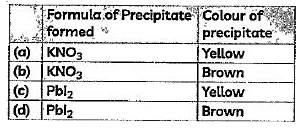When potassium iodide solution is added to a solution of lead nitrate in a testtube, a precipitate is formed.
List any two types of reaction in which this reactions can be placed.
To answer the question regarding the reaction that occurs when potassium iodide is added to lead nitrate, we can break down the solution into clear steps.
1. Identify the Reactants:
- The two reactants in this reaction are potassium iodide (KI) and lead nitrate (Pb(NO3)2).
2. Write the Chemical Equation:
- When potassium iodide is mixed with lead nitrate, the reaction can be represented as:
2KI+Pb(NO3)2→PbI2↓+2KNO3
- Here, PbI2 is the precipitate formed, which is lead iodide.
3. Classify the Reaction:
- This reaction can be classified into two types:
- Precipitation Reaction: This is because a solid precipitate (lead iodide) is formed from the reaction of two aqueous solutions.
- Double Displacement Reaction (or Double Decomposition Reaction): This is because the ions in the reactants exchange partners. The potassium ions (K+) from potassium iodide swap places with the lead ions (Pb²+) from lead nitrate.
Final Answer:
The two types of reactions in which this reaction can be classified are:
1. Precipitation Reaction
2. Double Displacement Reaction (or Double Decomposition Reaction)
- The two reactants in this reaction are potassium iodide (KI) and lead nitrate (Pb(NO3)2).
- When potassium iodide is mixed with lead nitrate, the reaction can be represented as:
2KI+Pb(NO3)2→PbI2↓+2KNO3
- Here, PbI2 is the precipitate formed, which is lead iodide.
- This reaction can be classified into two types:
- Precipitation Reaction: This is because a solid precipitate (lead iodide) is formed from the reaction of two aqueous solutions.
- Double Displacement Reaction (or Double Decomposition Reaction): This is because the ions in the reactants exchange partners. The potassium ions (K+) from potassium iodide swap places with the lead ions (Pb²+) from lead nitrate.
The two types of reactions in which this reaction can be classified are:
1. Precipitation Reaction
2. Double Displacement Reaction (or Double Decomposition Reaction)
Topper's Solved these Questions
- DIKSHA QUESTIONS Book:OSWAL PUBLICATIONChapter:DIKSHA QUESTIONS Exercise:CHEMICAL REACTION (LONG ANSWER)
Explore 26 Videos
- DIKSHA QUESTIONS Book:OSWAL PUBLICATIONChapter:DIKSHA QUESTIONS Exercise:CHEMICAL REACTION (MULTIPLE CHOICE QUESTION)
Explore 13 Videos
- DIKSHA QUESTIONS Book:OSWAL PUBLICATIONChapter:DIKSHA QUESTIONS Exercise:PERIODIC CLASSIFICATION OF ELEMENTS (MULTIPLE CHOICE QUESTIONS)
Explore 13 Videos
- CHEMICAL REACTIONS AND EQUATIONSBook:OSWAL PUBLICATIONChapter:CHEMICAL REACTIONS AND EQUATIONSExercise:CASE-BASED MCQs
Explore 29 Videos
- METALS AND NON - METALS Book:OSWAL PUBLICATIONChapter:METALS AND NON - METALS Exercise:CASE - BASED MCQs
Explore 29 Videos
Similar Questions
When potassium iodide solution is added to a solution of lead nitrate in a testtube, a precipitate is formed.
Write the balanced chemical equation for this reaction.
View SolutionWhen potassium iodide solution is added to a solution of lead nitrate in a testtube, a precipitate is formed.
What is the colour of this precipitate? Name the compound precipitated.
View Solution
Knowledge Check
When Potassium Iodide solution is added to a solution of Lead Nitrate,then what is color of precipitate of Lead Iodide
ABlackBBlueCRedDYellow
When potassium iodide solution is added to a solution of lead (II) nitrate in a test tube, a precipitate is formed.
(a) What is the colour of this precipitate? Name the compound precipitated.
(b) Write the balanced chemical equation for this rection.
(c) List two types of reactions in which this reaction can be placed.
View SolutionPotassium iodide solution is added to lead nitrate solution in a test tube. Select the correct observation from the table below:

View Solution(i) What is observed when a solution of potassium iodide is added to a solution of lead nitrate taken in a test tube?
(ii) What type of reaction is this?
(iii) Write a balanced chemical equation to represent the above reaction.
View SolutionWhen sodium chromate solution is mixed with barium sulphate solution , a precipitate is formed .
What is the type of chemical reaction?
View Solution(a) What happens when potassium iodide solution is added to lead nitrate solution? Give equation of the reaction involved. What type of reaction is represented by this example?
(b) Give one example of another reaction which is of the same type as the above reaction.
View SolutionSilver nitrate solution is added to NaCI solution. The reaction is a ………….. reaction.
View Solution(i) What is observed when a solution of potassium iodide to a solution of lead nitrate taken in a test tube ?
(ii) What type of reaction is this ?
(iii) Write a balanced equation to represent the above reaction.
View Solution

